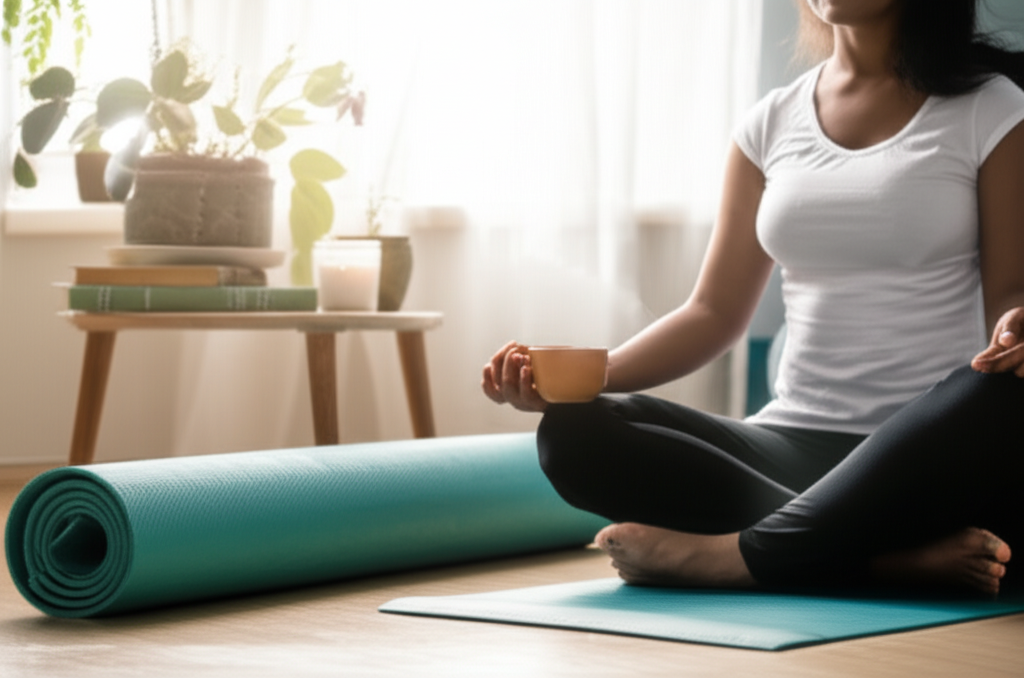
Digital Detox for Mental Health: Reclaiming Your Peace in 2025
Learn how to create healthy boundaries with technology and social media to protect your mental health and improve your overall well-being in our hyperconnected world.
# Digital Detox for Mental Health: Reclaiming Your Peace in 2025
In our hyperconnected world, the average person checks their phone 96 times per day and spends over 7 hours looking at screens. While technology has brought incredible benefits, it's also contributing to rising rates of anxiety, depression, and sleep disorders. As we navigate 2025, learning to create healthy digital boundaries isn't just helpful - it's essential for mental wellness.
## The Hidden Mental Health Cost of Digital Overload
### The Science Behind Screen Addiction
Recent neuroscience research reveals that excessive screen time literally rewires our brains. The constant dopamine hits from notifications, likes, and new content create addiction-like patterns that can lead to:
**Immediate Effects:**
- Increased cortisol (stress hormone) production
- Disrupted sleep patterns due to blue light exposure
- Shortened attention spans and difficulty concentrating
- Heightened anxiety when separated from devices
- Comparison-induced depression from social media
**Long-term Consequences:**
- Chronic stress and burnout
- Weakened real-world relationships
- Decreased emotional regulation skills
- Impaired memory formation
- Increased risk of depression and anxiety disorders
### The Social Media Mental Health Crisis
Studies show that heavy social media use is linked to:
- 70% higher rates of depression in teens and young adults
- Increased body dysmorphia and eating disorders
- FOMO (Fear of Missing Out) and chronic dissatisfaction
- Cyberbullying and online harassment
- Sleep disruption affecting 60% of users
## Signs You Need a Digital Detox
### Physical Symptoms:
- Eye strain, headaches, or "computer vision syndrome"
- Neck and shoulder pain from "text neck"
- Disrupted sleep or insomnia
- Fatigue despite adequate rest
- Increased frequency of illness (stress weakens immunity)
### Mental and Emotional Signs:
- Feeling anxious when your phone battery dies or you have no signal
- Compulsively checking devices even when no notifications are present
- Difficulty concentrating on tasks without checking your phone
- Feeling depressed or inadequate after social media use
- Irritability when unable to access devices
### Behavioral Red Flags:
- Reaching for your phone first thing in the morning
- Using devices during meals or social interactions
- Staying up late scrolling despite being tired
- Feeling like you're missing out if you're not constantly connected
- Neglecting real-world activities and relationships
## The 2025 Digital Detox Blueprint
### Phase 1: Awareness and Assessment (Week 1)
**Track Your Usage:**
- Use built-in screen time tracking (iOS Screen Time, Android Digital Wellbeing)
- Note emotional states before and after device use
- Identify your biggest digital triggers and time-wasters
- Assess which apps and platforms affect your mood most negatively
**Digital Audit Questions:**
- Which apps do I use most frequently?
- When do I reach for my phone automatically?
- How do I feel after using social media?
- What am I avoiding when I scroll mindlessly?
- Which digital habits serve my goals and which don't?
### Phase 2: Strategic Reduction (Weeks 2-3)
**The 3-2-1 Rule:**
- No screens 3 hours before important meetings or creative work
- No screens 2 hours before bedtime
- No screens for the first 1 hour after waking up
**App Decluttering:**
- Delete apps that consistently make you feel worse
- Move social media apps off your home screen
- Turn off non-essential notifications
- Use grayscale mode to make your phone less visually appealing
- Set specific times for checking email and messages
**Create Phone-Free Zones:**
- Bedroom (use an analog alarm clock)
- Dining areas during meals
- Bathroom (yes, really!)
- Car (use hands-free only for navigation)
- First and last 30 minutes of your day
### Phase 3: Mindful Reintegration (Week 4 and beyond)
**Intentional Usage:**
- Set specific purposes before picking up your device
- Use the "pause and breathe" technique before opening apps
- Practice the 20-20-20 rule: Every 20 minutes, look at something 20 feet away for 20 seconds
- Schedule "digital appointments" rather than constant connectivity
**Quality Over Quantity:**
- Curate your social media feeds to include only positive, inspiring content
- Unfollow accounts that trigger comparison or negative emotions
- Follow accounts focused on education, inspiration, and genuine connection
- Engage meaningfully rather than passively consuming
## Alternative Activities for Digital Wellness
### Morning Routines Without Screens:
- Meditation or mindfulness practice
- Journaling or gratitude writing
- Gentle stretching or yoga
- Reading physical books or magazines
- Enjoying breakfast mindfully
- Taking a walk in nature
### Evening Wind-Down Activities:
- Taking a warm bath with Epsom salts
- Reading fiction before bed
- Practicing gentle yoga or stretching
- Listening to calming music or podcasts
- Doing puzzles or creative activities
- Having meaningful conversations with loved ones
### Social Connection Alternatives:
- Meeting friends for coffee or walks
- Joining local clubs or hobby groups
- Volunteering in your community
- Taking classes or workshops
- Participating in outdoor activities
- Having phone calls instead of texting
## The Mental Health Benefits of Digital Detox
### Immediate Benefits (1-2 weeks):
- Improved sleep quality and duration
- Reduced anxiety and stress levels
- Better focus and concentration
- Increased present-moment awareness
- More energy and motivation
### Medium-term Benefits (1-3 months):
- Stronger real-world relationships
- Improved self-esteem and body image
- Better emotional regulation
- Increased creativity and problem-solving skills
- Greater life satisfaction and contentment
### Long-term Benefits (3+ months):
- Reduced risk of depression and anxiety
- Improved cognitive function and memory
- Better physical health markers
- Stronger sense of personal identity
- More meaningful life experiences
## Creating Sustainable Digital Boundaries
### The 80/20 Approach:
- 80% of your digital use should be intentional and purposeful
- 20% can be for entertainment and casual browsing
- Regularly reassess and adjust these boundaries
### Family and Relationship Boundaries:
- Establish device-free meal times
- Create "connection hours" without screens
- Model healthy digital habits for children
- Communicate your boundaries clearly to others
- Respect others' digital boundaries
### Work-Life Digital Balance:
- Set specific hours for checking work emails
- Use separate devices or accounts for work and personal use
- Take regular breaks from screens during the workday
- Advocate for reasonable digital expectations at work
- Practice saying no to unnecessary digital commitments
## Troubleshooting Common Challenges
### "I Need My Phone for Work"
- Use app timers and restrictions for non-work apps
- Keep work and personal apps separate
- Set specific times for checking personal messages
- Use a physical planner alongside digital tools
- Take regular micro-breaks from screens
### "I'll Miss Important Information"
- Most "urgent" information isn't actually urgent
- Set up emergency contact methods for truly important calls
- Use email filters and folders to prioritize messages
- Schedule specific times for news consumption
- Trust that important information will reach you
### "My Friends Will Think I'm Antisocial"
- Explain your digital wellness goals to close friends
- Suggest alternative ways to connect
- Be consistent with your boundaries
- Lead by example rather than preaching
- Find friends who support your wellness goals
## Technology Tools for Digital Wellness
### Helpful Apps and Features:
- **Freedom or Cold Turkey**: Block distracting websites and apps
- **Forest or Flora**: Gamify focus time with virtual tree planting
- **Moment or RescueTime**: Track and analyze your digital habits
- **Headspace or Calm**: Meditation apps for stress reduction
- **Sleep Cycle or Pillow**: Monitor and improve sleep without screens
### Phone Settings for Wellness:
- Enable Do Not Disturb during focus times
- Use grayscale mode to reduce visual appeal
- Set app time limits and stick to them
- Turn off badge notifications for non-essential apps
- Use airplane mode for deep focus periods
## The Ripple Effect: How Your Digital Detox Helps Others
When you model healthy digital boundaries:
- You give others permission to do the same
- You create more meaningful in-person interactions
- You reduce the pressure for constant connectivity
- You contribute to a culture of mindfulness and presence
- You protect the mental health of those around you
## Your 30-Day Digital Detox Challenge
**Week 1: Awareness**
- Track your current usage without judgment
- Notice emotional patterns around device use
- Identify your biggest digital triggers
**Week 2: Boundaries**
- Implement the 3-2-1 rule
- Create phone-free zones in your home
- Turn off non-essential notifications
**Week 3: Alternatives**
- Replace one hour of screen time daily with offline activities
- Try new hobbies or revisit old ones
- Focus on in-person social connections
**Week 4: Integration**
- Develop sustainable long-term practices
- Reflect on changes in mood, sleep, and relationships
- Create a personalized digital wellness plan
## Conclusion: Reclaiming Your Mental Space
Digital detox isn't about rejecting technology entirely - it's about using it intentionally to enhance rather than diminish your life. In 2025, as our world becomes increasingly connected, the ability to disconnect becomes a superpower for mental health.
Remember, this is a practice, not a perfection. Start small, be patient with yourself, and celebrate every step toward greater digital wellness. Your mental health, relationships, and overall life satisfaction will thank you.
---
*Ready to start your digital detox journey? Subscribe to my newsletter for weekly tips on digital wellness and mental health, plus get my free 7-Day Digital Detox Starter Kit with practical tools and tracking sheets.*
"The most sustainable morning routine is the one that honors your natural rhythms, not the one that looks perfect on social media."
The Gentle Approach to Morning Routines
Instead of trying to cram everything into the first hour of your day, what if you chose just one or two things that truly serve you? Here's how to build a morning routine that feels nourishing, not overwhelming:
1. Start with Your Non-Negotiables
What are the absolute essentials that help you feel grounded? For me, it's five minutes of deep breathing and a cup of herbal tea. That's it. Some days I add journaling or gentle movement, but those two things are my foundation.
"Instead of trying to cram everything into the first hour of your day, what if you chose just one or two things that truly serve you?"
2. Honor Your Chronotype
If you're naturally a night owl, forcing yourself to wake up at 5 AM might do more harm than good. Research by Dr. Michael Breus shows that working with your natural sleep-wake cycle, rather than against it, leads to better energy and mood throughout the day.
Tweet This:
"The most sustainable morning routine is the one that honors your natural rhythms, not the one that looks perfect on social media."
3. Focus on How You Want to Feel
Instead of focusing on what you should do, ask yourself: How do I want to feel as I start my day? Calm? Energized? Grounded? Then choose activities that cultivate those feelings.
Remember, the goal isn't to have the most impressive morning routine. The goal is to start your day in a way that supports your wellbeing and sets you up for success—whatever that looks like for you.

About Pratima Khatri
Pratima is a digital creator and content strategist specializing in women's health, nutrition & wellness, lifestyle habits, and writing & blogging. She helps women navigate their wellness journey through gentle guidance and evidence-based insights, creating content that connects and stories that inspire bold living.